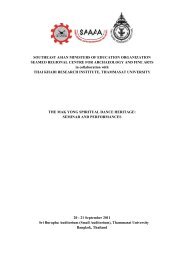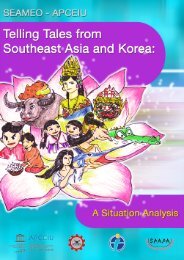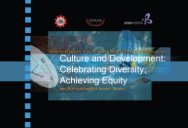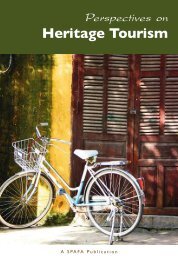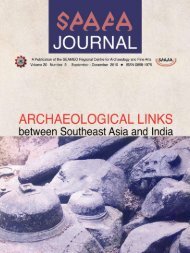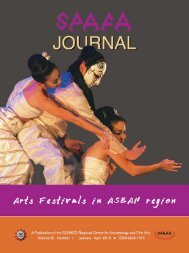Making Mangrove - Seameo-SPAFA
Making Mangrove - Seameo-SPAFA
Making Mangrove - Seameo-SPAFA
Create successful ePaper yourself
Turn your PDF publications into a flip-book with our unique Google optimized e-Paper software.
The Site Development of the <strong>Mangrove</strong>Forest, Tabon Cave ComplexWilfredo Vendivil andErnesto B Toribio Jrburial sites in the ancient times. The famous archaeologistDr. Robert Fox and the National Museum team haveunearthed sites that reveal 50,000 years of Philippineprehistory, with invaluable findings such as the Tabonman skull cap and the Manunggul burial jar.The origin of ‘Tabon’ can be traced back to the localscrub fowl of the same name. The amazing biodiversity ofthe Tabon Cave Complex can be observed in its myriadnatural habitats such as the karst forest, beach forest,coconut plantation, marine environment, and mangroveforest. The karst forest is a limestone landscape thatdominates the complex, while the marine ecologyencompasses beautiful coral formation, the habitat ofa diverse species of fish and sea grass beds that areessential for many fish and turtles. There is also a widevariety of local species of crabs, indigenous birds likethe Palawan hornbill and rare bats that reside in thecaves, making the complex a vast home to natural lifeforms.Preserving Tabon Cave ComplexThe presenter reported that given the richness of theTabon Cave Complex, it was declared a Site MuseumReservation pursuant to the Presidential ProclamationNo. 996. As mandated by law, the National Museum isthe administrator tasked to protect and preserve thisreservation for the present and future generations.Site development projects have been proposed as jointefforts of various government agencies, such as theNational Museum; the Department of Tourism Authority;the local government of Quezon, Palawan; and theNational Commission on the Arts.The development plans have started since 1970,with the establishment of the National Museum Branchto better administer the site museum as well as to protectand preserve the resources. Coordination has been madewith the local government to impose local laws for theconservation of natural and cultural assets. Since then,ongoing efforts have been made to improve the qualityof the exhibits and carry out other works, including:• landscaping of the ground of the branch museum• construction of the boardwalk leading to the caves• installation of signage on the geology, flora, fauna,and archaeological resources• rehabilitation of the eco-tourism trails• tour guides’ training for the local community• publication of guidebooks• production of audio-visual materials• establishment of co-operatives of handicraftentrepreneurs and boat owners• development of the mangrove forest.Development of the <strong>Mangrove</strong> ForestThe main objective of developing the mangrove forest, asthe speakers described it, is to create a living laboratoryto study its importance to the community and tohumanity. The other specific objectives of this projectare as follows:1. To conduct an extensive study of the formation ofthe mangrove forest at the complex2. To carry out an inventory of flora and fauna3. To observe the ecological status of the mangroveforest4. To document through photography the dominantplants and animals5. To construct a boardwalk and observatory platformswithin the mangrove forest6. To install signage in key areas of the boardwalk7. To prepare a guidebook on the protection of themangrove forest8. To involve the community in the protection andpreservation of the mangrove forestThe development of the mangrove forest into aneco-museum is a significant project. As the mangroveforest connects the Tabon Cave Complex to themainland of Palawan, it serves as a sanctuary for marine60 <strong>Making</strong> <strong>Mangrove</strong> Eco-Museums<strong>Making</strong> <strong>Mangrove</strong> Eco-Museums 61



